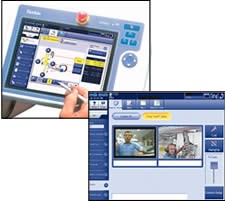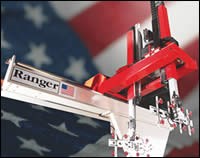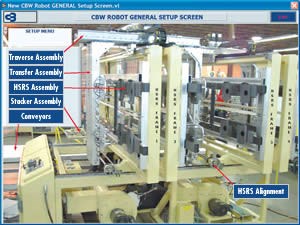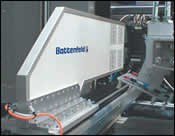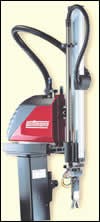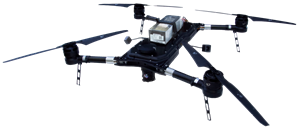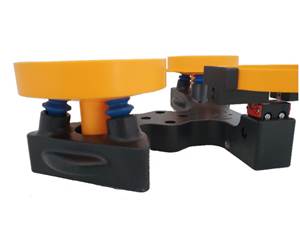NPE News Wrap-up: Robots
From micro to maxi, from simple sprue pickers to sophisticated six-axis models, NPE had it all. A raft of new robots, faster and smarter than ever, will help make automation an irresistible choice for U.S. molders.
If one theme could characterize the robot exhibits at the NPE show in Chicago, it is that molders want more from their automation investment. They want more speed and precision, more flexibility, and more ease of programming. “Molders would like to do more than pick and place, more than just take parts out of the machine,” says Wittmann president David Preusse.
Robot vendors at the show said they are responding to growing demand for greater value-added functions—from vision systems for parts inspection and identification to downstream operations like degating, trimming, assembly, and packing. Suppliers addressed these demands with a breathtaking array of new jointed-arm, traversing, and hybrid styles with higher levels of programming and control. More suppliers are opting for PC-based Windows software and icon-based graphical interfaces to make robot programming easier. Also new is PC-based simulation software that gives users a new way to program robot sequencing and spot trouble without building a prototype cell. “Relying on the power of a PC instead of a PLC is one way to take automation to new levels of use,” says Joe Calomino, robotics product manager at Husky.
Communications play a larger role than ever in the new robot controls. Some permit remote monitoring through a network or from the Web. Some even let you hold online meetings on the shop floor. “We used Weblink at the show to link all of the robots and auxiliaries in our booth and allow the molder to look at an individual workcell for data or error messages,” says Preusse. “The Web can show you if a machine is down, why it is down, and how long it was down. The user could also get an e-mail about his process through a PDA device.”
Six-axis, jointed-arm robots, which are typically used for secondary or downstream operations, were more plentiful at this year’s show than in the past. Says Jeff Parker, marketing manager at Staubli, “A six-axis robot can perform any motion a person can do. That can be overkill for a normal pick-and-place operation, but even there it may show some advantage—perhaps pulling parts from two different molds or reaching into the mold from different sides of the press. So molders with many part-handling tasks are getting to know the capabilities of a six-axis robot. We estimate that it can do the job of two or three people.”
Joe Portelli, plastics industry program manager for Fanuc Robotics, knows of one molder that is putting six-axis robots on every one of its 18 presses. “He wants to execute part takeout, inspection, stacking, and palletizing with one robot.
“The general consensus is that this NPE show had more automation in general,” adds Portelli. “Many have told me that automation is the one remaining way to compete with low-cost labor overseas. So along with the traditional reasons to automate—including process consistency, productivity, and quality control—labor savings are taking a higher profile.”
Even short-run molders are beginning to learn the value of investing in flexible automation, according to Hank Dixon, executive v.p. of automation at Conair. “This trend is extending even to smaller parts molded on smaller machines, which historically have been less frequently automated,” he notes.
More linear servos
At NPE, one more supplier introduced linear servo drives on its traversing robots. Unlike conventional servos, linear drives use an electromagnetic field to drive a moving coil along a linear magnet (or vice versa). They cost 40% to 50% more than standard servos but provide higher speed and precision, suppliers say. They also eliminate wear-prone gear boxes, drive belts, and rack-and-pinion systems.
The market for linear servos is still limited by their high price. “Standard AC servo is more suited to many applications at the moment,” concedes Paul Olnick, v.p. of marketing at Mark 2 Automation, the first firm to introduce linear-servo robots here three years ago. “We’ve sold about a dozen so far to four or five injection molders.”
Mark 2 now offers the linear drive on its 400 and 480 EL2-3S Eagle robots. They have a linear motor on the traverse (x) axis and standard servos on the other two axes. The linear motor can zip 156 in. in 2 sec with positioning repeatable to ±0.001 in. Mark 2 also updated its ECP3000 touchscreen PC controller, which now can display the complete operator’s manual.
Three other vendors of linear servo robots—AEC, Hekuma, and Star Seiki of Japan (represented here by Star Automation)—did not bring them to the show. But Yushin America chose the occasion to unveil its first linear servo models, the NCR series, which boast speeds 15% to 20% higher than standard servo robots. They will be available here in 2004. The NCR-150 model shown at NPE is capable of extraction times of 0.3 sec and an overall mold cycle of 3.5 sec.
Six-axis servos sizzle
Six-axis, jointed-arm servo robots can stand on a stationary base or slide along a beam or gantry. The latter is described as a “hybrid” of the jointed-arm and traversing types. Fanuc Robotics, which pioneered the hybrid concept with its Toploader series four years ago, introduced two new models plus a new controller and vision package. Its new M-16iB/20T handles payloads up to 44 lb and is suited to injection machines up to about 800 tons. (It’s also available in floor- or platen-mounted versions without a traverse beam.) Model M-710iB/T is for machines of 1000 to 2500 tons. Payload capacity is up to 154 lb and vertical reach is up to 1900 mm.
Both robots have the new R-J3iB controller with web-enabled, color graphic “i Pendant.” The controller delivers faster processing and more memory, I/O, and communications capability than previous styles. Fanuc Robotics also rolled out its visLOCi vision software, which links a camera and PC to the new controller. Users “teach” the vision system how to recognize a part in three upright and layflat positions. When the robot recognizes a part, it ascertains its orientation and how to pick it up.
A new line of hybrid six-axis, articulating gantry robots was designed specifically for plastics by Staubli Robots Div. This RXplastics line comes in 15 models with payload capacity to 132 lb. They are designed for presses from 50 to 1000 tons. Staubli increased the robots’ angular joint speed so they can get in and out of the mold faster. It also added a patented gear-reduction system for more precise positioning.
The new CS8 controller can be programmed from the teach pendant. New PlasticsAssistant software reportedly makes six-axis programming easier. Another software feature automatically determines how to place parts in a tray or pallet based on just the initial placement position and the dimensions of the tray. The controller also displays production data like cycle times, mold open/close times, cycles completed, good parts produced, and even mold temperatures. Unique among jointed-arm robots, says Staubli, the CS8 contains an SPI/Euromap interface that simplifies communication with the press.
Tasks like trimming and routing are easy for Motoman’s new DX1350 six-axis floor model. Its wrist joint is protected against dust and temporary immersion in water. It supports a 77-lb payload and reportedly has the highest speed and wrist-torque ratings in its class. The XRC 2001 controller provides position repeatability of ±0.002 in.
Motoman also rolled out two lines of smaller four-axis robots for high-speed, high-precision assembly of small parts. The HS series has a reach from 350 to 550 mm and 11-lb payload capacity, while the HM series has a reach from 600 to 1000 mm and 44-lb payload limit. At NPE, Motoman partnered with Cognex to integrate its robot with a DVT vision system in a workcell that combined parts handling with conveyor tracking.
Motoman also offers the new PX series of six-axis painting robots. Among six models is one that’s said to be the world’s smallest.
Reis Robotics showed a six-axis robot with new laser cutting and trimming system for auto interior parts. It has integrated laser-beam guidance.
New top-entry designs
Husky updated its Tracer line of top-entry servo robots. The four models have longer vertical strokes and a choice of payload capacities from 6.6 to 132 lb, suitable for machines from 100 to 6000 tons. With new “part-tracking” synchronized motion, the robot moves in parallel with the clamp or ejector, so that it contacts the part while the mold is opening. This trims cycle times, especially for deep-draw parts. The series also is now offered in a dual in-line configuration (two robots on one beam parallel to the machine axis) for tandem or stack molds.
Thin-wall parts requiring very short extraction times are the target for Wittmann’s new high-speed W633 servo robot with two-stage telescoping arm. Its new microprocessor controller with graphical interface can program downstream equipment, allowing the robot to run an entire workcell. Programs can be stored on smart cards.
Windows XP-based control and absolute position encoders are features of Yushin’s new Webliner RA servo robots. The three- or five-axis models have one- or two-stage vertical arms and handle payloads up to 33 lb. They fit presses from 30 to 1000 tons. Absolute encoders help the robot remember its position in the event of a power loss.
Yushin’s new Windows XP-based, web-enabled E-touch controller with a touchscreen permits Ethernet message communication and data transmission. Users can send programs directly to other robots without using a floppy disk. Attaching an optional USB camera and microphone allows remote maintenance, online meetings, and—in the future—remote technical support.
New Double-Arm five-axis robots from Ranger Automation can reach simultaneously into multiple parting lines on stack or three-plate molds. They come in a high-speed version for presses from 200 to 1000 tons and in a larger version for machines from 1000 to 5000 tons. The latter has vertical stroke up to 14 ft.
Ranger also introduced an optional servo wrist flip for all its new robots. This option reduces mold-open time in cases where it’s necessary to lift parts to dislodge them from a lifter or core. Ranger also introduced a new multi-axis servo degater arm that provides precise part trimming. Mounted on the traverse beam, it allows cutting position to be fine-tuned on-the-fly.
Conair’s new SR4040 model is the largest in its recently introduced Generation IV line of servo robots. Suited to presses up to 1000 tons, it has two new servo wrist rotations that let it pick parts from both mold halves and more easily manipulate parts for post-mold fixturing. An optional telescoping arm has vertical stroke of almost 70 in.
Generation IV robots have Conair’s new Visual controller, which offers three different programming methods—on-screen prompts, preprogrammed templates, or free programming. The touchscreen controller is a simple icon-based graphical type, yet it comes with 8MB of memory and can hold up to 650 programs. It has enough processing power to control the robot and peripheral equipment simultaneously.
Simple operations like demolding and degating are jobs for Wittmann’s economical new W720 robot. It has a servo-driven horizontal axis and pneumatic drive of the vertical axis and fixed kick stroke. It carries 11-lb payloads from presses up to 330 tons.
Remak’s new RX 32 three-axis servo robot fits machines up to 300 tons. Its SPS 2000 control is mounted on the horizontal beam to save space. The handheld teach pendant with LCD can program up to 30 sequences and 30 subprograms with up to four palletizing programs available for each sequence. An optional ChipCard Reader allows storage of set-ups on smart cards.
Remak updated its RX 51 three-axis robots for enhanced rigidity and stability. Suited to pick-and-place operations on machines up to 400 tons, they have two guides and a wear-resistant brake on each axis.
New RZ-V five-axis servo models from Sailor USA can deliver extraction dry cycles as short as 0.8 sec and overall dry cycles of 5 sec. They handle payloads up to 33 lb. For extra durability, the robot uses ball screws on the traverse motion and rack-and-pinion mechanisms on two other axes. Vibration suppression in the vertical arm is said to reduce shaking by 33%. The integrated power supply and amplifier system reuse energy recovered during motor deceleration. Other features include a 12-in. touchscreen on the control pedestal and a voice-recognition system for control and programming that is said to be an industry first.
Keeping a low profile
Two top-entry beam robot series designed to extract large parts in low-headroom situations are new from Ranger Automation. Its F-series three-axis servo robots have a flat-front arm and overhanging carriage frame that won’t interfere with the top of a large part. The design reportedly permits handling tall parts with a shorter robot. The series can be used with rack molds or other mold obstructions on presses from 100 to 3000 tons.
Ranger also rolled out an Ultra-Compact Wide-Body series with space-saving three-stage telescopic arm. The wide frame of these five-axis models handles parts as wide as the tiebar spacing on presses of 1000 tons or more.
Ranger also developed a new programming kit called Mold Editor that has a working simulation of the robot touchscreen pendant. It allows off-line creation of robot sequences in a remote location. Programs can be downloaded to the robot via a data network.
Ranger’s servo-robot controls also now have “quick-teach” Create-A-Mold software that assists operators in setting up a robot sequence. The program prompts the operator with questions, such as how many vacuum or gripper circuits are being used by the robot tooling, how many part or release positions are needed, and where the time delays and speed changes occur.
The new VNR II low-profile servo robot from Yushin is designed for machines from 800 to 2000 tons yet requires just 69 in. of overhead clearance. Its telescoping arm is 30% lower than Yushin’s previous compound-arm models. The expanded kick frame allows parts to be brought up through it. An electric wrist is standard.
Yushin also rolled out the VNXII-1300SL-HS1.51 high-speed servo robot for presses of 800 to 2000 tons. It achieves dry-cycle extraction times as short as 1.57 sec and overall cycles of 16.4 sec. Payloads go to 55 lb.
An all-new control system is the highlight of the AERA line of all-servo robots introduced by AEC. Also, the height of the two-stage vertical arm has been reduced, and control components have been moved for easier access. Models suited to injection machines up to 700 tons will be available late this year, while robots for larger presses will come out early in 2004. AEC’s sister company Sterltech Robotics also offers the robot under the SRRA designation.
The new Windows XP control system has screens designed for specific personnel—operator, mold changer, programmer, or administrator. Programming is simplified with a graphical flow chart and lead-through-teach system. It also has absolute encoders and a new online operations manual that stores set-up notes for each mold. The web-enabled system provides access to e-mail, online “net meetings,” and remote maintenance.
New LS series servo robots from Ventax Robot are aimed at high-speed molding on presses from 100 to 5000 tons. Features include heavy-duty steel beam construction and a low-profile, telescoping y-axis with optional servo wrist. Mold-intrusion times are less than 1 sec. The fully teachable control includes a pendant with color screen, storage for 25 set-ups, and a mold-identification system.
For smaller presses
The new Raptor line of three-axis servo robots from Automated Assemblies has a new Windows PC-based control and graphical touchscreen that allow the user to control the robot and a complete workcell. The Raptor 1000 model handles presses from 30 to 150 tons and the Raptor 2000 is for 120 to 700 tons. Next year two models will be added for presses up to 3500 tons. The controller can integrate the company’s own vision inspection system. It also provides off-line programming and Ethernet connectivity for remote monitoring and troubleshooting. InteliMotion dynamic speed control automatically runs the robot at the highest possible speed for each program step.
New from Yushin are low-cost, all-servo traverse robots for presses from 30 to 300 tons. The VSX series costs 15% less than previous models and needs 9% less headroom. It can handle payloads up to 11 lb with a single-stage vertical arm. The control box is on the horizontal beam, saving floor space. The E-touch handheld mini-controller has a 6.5-in. color touchpanel and basic icon-driven function buttons. Programming is accomplished by assembling sequence options. It also has help and troubleshooting screens, as well as storage capacity for 100 set-ups.
Wittmann’s new Compact series of three-axis servo robots has a new microprocessor controller in a drawer in the horizontal beam. The teach pendant has a graphical programming interface and stores programs on smart cards. Suited to presses from 50 to 500 tons, the robots can hit a top speed of 200 in./sec and handle payloads up to 50 lb. A larger horizontal beam adds stability, and a new bearing system (now on all Wittmann’s traversing robots) dampens vibration and absorbs shock.
Ranger’s new Value series of top-entry robots for machines of 50 to 500 tons have a single-stage vertical arm, space-saving controller built into the robot, and touchscreen operator pendant—all for less than $30,000.
AEC introduced an “entry-level” line of three-axis servo robots for basic pick-and-place, stacking, and inspection jobs. The AE-SB series is priced in the low to mid $20,000 range and has a single- or dual-stage telescopic arm and a simple handheld control pendant. Fifteen models carry maximum payloads of 13 lb. Sterltech Robotics offers these robots under the SR-SB name.
Star Automation’s FM III three-axis servo robots were redesigned and renamed the V series. They fit machines of 40 to 300 tons. The vertical arm is now steel instead of aluminum for greater rigidity and payload capacity (4.4 to 11 lb). It has a smaller control box and other space-saving modifications, plus electronic vibration control and a link-less cable track that reduces dust and noise. The STEC-460 controller saves energy by cutting off electric current to the motors of unused axes.
Mark 2 Automation added longer vertical-stroke options to its EL3 line of three-axis servo models for presses of 50 to 1000 tons. New reach lengths are 72, 84, and 96 in.
Fast side-entry models
Wittmann’s new W625H side-entry robot can get in and out of a mold in 0.3 to 0.4 sec. It can be used for fast-cycle demolding or as a label inserter for in-mold decorating.
Battenfeld claims takeout times as short as 0.1 sec for its new SER 10-15 side-entry robot. It runs on a rail and reaches speeds of 196 in./sec. The unit handles payloads up to 22 lb and has a shock absorber and integral ionization module to prevent static build-up.
CBW Automation showed new two-level and four-level side-entry robots for molds with multiple parting lines. They can stack parts after demolding. At the show, a two-level system designed to handle lids or containers in presses up to 300 tons ran within a cycle less 3.5 sec.
CBW also rolled out its new Windows XP-based Lumera controls designed to make robots easier to program and operate. Their customized set-up screens display photos of the hardware components as they are being programmed, which is said to speed set-up and help to eliminate mistakes. Troubleshooting is aided by close-up pictures of the area of the fault, enhanced with labels and arrows, plus a detailed description of the problem and a list of possible remedies. The software gives access to electrical drawings, blueprints, installation procedures, and parts lists. It also can generate reports.
Yushin developed a new side-entry servo robot for micromolding. The SX-mini I for presses from 5 to 15 tons handles payloads up to 2.2 lb. It has a color touchscreen controller.
Ventax Robot displayed its recently introduced Viper SE side-entry robot with a rail-mounted articulating arm (see PT, March ’03, p. 12). It also comes in low-profile top-entry models.
Smarter sprue pickers
Yushin’s new “G”-type controller with production-data recording and storage of 15 set-ups appears on the new HOPIV sprue picker for machines of 40 to 200 tons. The main arm is lighter and more rigid, permitting 20% faster takeout (0.2 to 0.4 sec) and 12% shorter overall dry cycles than the HOPIII model. It handles 4.4 lb. The new control also comes on the N-HOPIII, which has a servo kick axis.
Wittmann’s new W602 sprue picker has a microprocessor-controlled pneumatic shock absorber and maintenance-free guide system that reportedly eliminate vibration even at the highest speed. The steadier picker can align itself more quickly with the part to execute the takeout function. A new tilt feature on the gripper can pivot up to 20°, allowing the gripper to reach around a part to grab the sprue.
At NPE, Wittmann interfaced the picker’s control to a granulator. A sensor in the granulator monitored the amount of sprues in the feed throat. If the grinder became overloaded, the picker diverted sprues to another location.
Remak updated its RX 5 picker with a longer strip stroke (3 in.), more wear-resistant bearings on the traverse (x) stroke, and redesigned pneumatic drive to accommodate very fast movements. Remak also introduced the larger model RX 15 for machines up to 400 tons. Its vertical stroke is up to 33.6 in. Takeout can be as quick as 1.2 sec.
Ranger’s new SSR series servo picker is a three-axis unit that performs like a traversing robot, but at a cost starting under $10,000. Servo drive provides high-speed take-out, teachable and more accurate part/runner release positions, and ability to pre-stage the vertical arm over the mold to reduce takeout stroke. A touchscreen pendant with Quick Teach modes speeds set-ups and displays part and reject counts. Special programmable motions allow the picker to release parts on one side of the machine and runners on the other.
Star Automation introduced its new XQ0600V sprue picker, which has a 600-mm vertical stroke.
Related Content
What to Look for in High-Speed Automation for Pipette Production
Automation is a must-have for molders of pipettes. Make sure your supplier provides assurances of throughput and output, manpower utilization, floor space consumption and payback period.
Read MoreBMW Group Vehicle to Adopt 3D Printed Center Console
A vehicle coming to market in 2027 will include a center console carrier manufactured through polymer robot-based large-format additive manufacturing (LFAM).
Read MoreDrones and Injection Molding Ready for Takeoff
Drones and unmanned aerial vehicles (UAV) are approaching an inflection point where their production volumes — and functionality — will increasingly point to injection molding.
Read MoreEnsuring Repeatability: The Key to Effective Injection Molding Automation
One of automation’s key promises is repeatability: the same movement to the same location, time and time again. But to achieve that, all elements involved — robot, machine, EOAT, mold — must be in and stay in alignment.
Read MoreRead Next
People 4.0 – How to Get Buy-In from Your Staff for Industry 4.0 Systems
Implementing a production monitoring system as the foundation of a ‘smart factory’ is about integrating people with new technology as much as it is about integrating machines and computers. Here are tips from a company that has gone through the process.
Read MoreMaking the Circular Economy a Reality
Driven by brand owner demands and new worldwide legislation, the entire supply chain is working toward the shift to circularity, with some evidence the circular economy has already begun.
Read More



